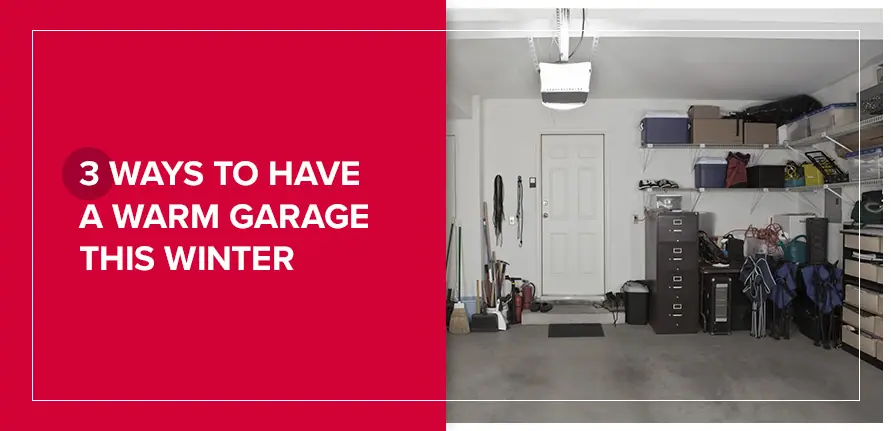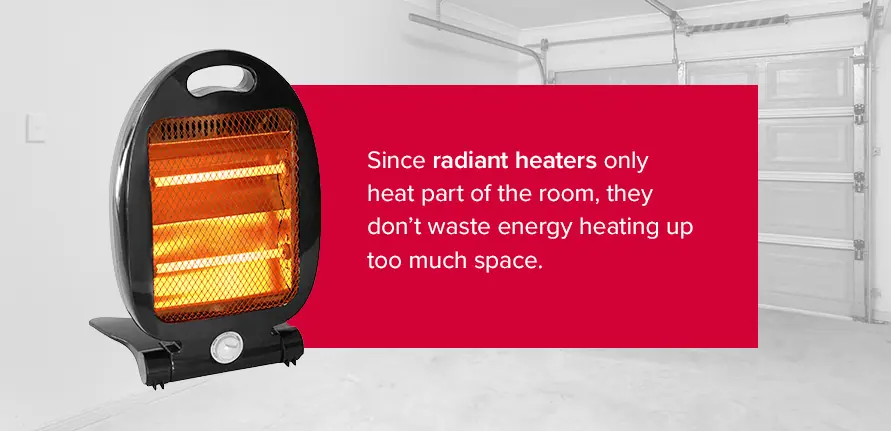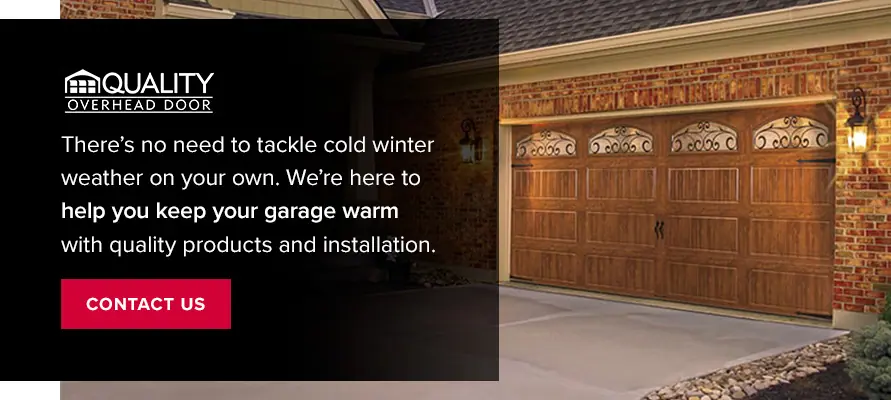A freezing garage is not a comfortable place to work on projects or hobbies. Frigid temperatures aren’t too great for stored liquids or equipment, either. Liquids like paints or glues won’t perform as they should in the cold, and any pieces of equipment containing water could freeze and crack.
Don’t neglect your garage during the winter, even if it is an uninsulated area of your home. Luckily, there are straightforward ways to create a warm, cozy space in your garage. You can enjoy this part of the house, even when those cold Toledo and Southeast Michigan winters try to tell you otherwise.
Whether you’re wondering how to heat a detached garage or how to make an attached concrete garage warm, the same principles apply to every garage — or any other room, for that matter. In this post, we’ll show you the best ways to heat a garage in the winter, so you can enjoy peace of mind and work on projects year-round.
Why Should You Prevent Heat Loss?
Sealing air leaks and adding insulation will give you the best results when you add a heat source to your garage. Heat flows from warmer to cooler temperatures, so insulation adds effective resistance to the flow of heat and will decrease heat loss. If you don’t seal gaps, holes or cracks and leave large spaces uninsulated, your heating efforts won’t be as effective — the warm air will slip away.
You’ll also spend less on utility bills when you prevent heat loss in your garage. According to Energy Star, the typical American household spends more than $2,000 a year on energy bills, and about 30% of that goes toward heating. When you seal air leaks and add the right amount of insulation, you reduce energy waste, utility bills and outside noise, all while increasing the comfort of your garage.
After learning of these advantages, you’ll likely want to look for some actionable strategies to figure out how to keep your garage warm in the winter. We’ll look at three effective ways to keep your garage at a comfortable temperature.
1. Identify Air Leaks and Insulate Those Areas
Before you do anything to winterize your garage, you need to determine where you’re losing heat. That way, you’ll know which areas need attention, and you won’t waste time or money addressing the wrong spots. You’ll mainly want to look for air leaks and areas that need insulation.
Air leaks are a major source of heat loss in the home and the garage during the winter. Heat loss can occur through air leaks in windows, doors and walls. Warm air can also leave through materials like glass or uninsulated walls or doors.
Common areas for air leaks and heat loss in the garage include the following:
- Walls: A lot of garages have uninsulated walls. Although insulation in itself won’t warm the garage, it will slow the transfer of heat to keep heat from escaping. If you plan on heating your garage, it’s a good idea to install insulation, such as fiberglass batt insulation, between wall studs. Be sure to choose insulation that’s the proper thickness for your walls, and carefully read the instructions to get a secure fit. Also, make sure to seal any tiny cracks or gaps you find in the walls or around outlets or switchplates. Lastly, check for gaps where the wall meets the floor, and seal the area with a foam sealant or caulk.
- Ceilings: Many garages have unfinished ceilings with only rafters overhead. You can reduce heat loss by installing insulation in the ceiling and adding wallboard.
- Windows: If you can see gaps around the windows in your garage or if the windows in your garage rattle, it’s likely you have air leaks you need to seal. You can easily add protection against cold air by installing a plastic film covering over the windows. Installing plastic wrap is an easy and affordable way to prevent window air leaks effectively.
- Passage doors: Air leaks commonly occur under doors, including the door leading to the main house from the garage. Installing a door sweep will close the gap between the door and the threshold and will help keep heat in the garage. You can also use a draft stopper for an easy solution, and caulk the trim around the door on the inside and outside.
- Garage door: Your garage door takes up a large portion of the wall in your garage, meaning there’s a lot of potential for heat loss in gaps under and around the door. If the door is uninsulated, heat can pass right through it. Consider adding insulation to your garage door or replacing an old garage door with a new, insulated door.
Identifying where those air leaks are coming from will help you get to the source of the problem. From there, you can start to look at strategies for heating your garage.
2. Add a Heat Source
After insulating your garage and addressing any air leaks, your next step will be choosing a heat source. There are a few different options to choose from — a mini-split system, propane heater and an electric space heater.
Mini-Split System
A mini-split is a ductless heating and cooling system. It has two components — an indoor unit and an outdoor condenser. A conduit connects these two parts. Most homeowners choose mini-splits for heating a single room, and they are ideal for spaces that have no ductwork — like a garage. You can get a mini-split system mounted to a wall or ceiling, or choose a freestanding unit.
These efficient units are much less complicated to install than an HVAC system. Since mini-splits have no ducts, you won’t experience ductwork-related heat loss. According to the Department of Energy, duct losses account for more than 30% of energy consumption for space conditioning.
Propane Heater
A propane heater is an excellent option for heating a garage because it offers a ton of warmth, it’s mobile and it’s an affordable way to add heat. Space heaters, including propane heaters, generally range between 10,000 British thermal units (BTUs) and 40,000 BTUs per hour. Select a propane heater that’s the right size for your garage.
To figure out the correct heater size, take the following steps:
- Measure your garage: First, measure the height, width and length of your garage.
- Calculate the total cubic feet: Next, multiply the length by the height and the width to get the total cubic feet of the area. For example, if your garage measures 10 feet long by 8 feet wide and 12 feet high, you’ll multiply all those numbers together and get an area of 960 cubic feet.
- Estimate the temperature increase: Estimate how much you wish the temperature to increase. To do this, research the lowest area temperature and subtract this number from the temperature you wish to maintain. For example, the average low in Toledo in January is 22 degrees Fahrenheit. If you want your garage to maintain a temperature of 68 degrees Fahrenheit, you’ll need a temperature increase of 46 degrees.
- Calculate the BTU you need: To finally calculate the BTU you need, first multiply the total cubic area by .133. Next, multiply that number by the temperature increase and round to the nearest thousand. Using the examples from above, you would need a heater with about 6,000 BTU.
When using a propane heater, make sure to set the heater on a flat surface away from flammable materials.
Electric Space Heater
A portable, electric space heater offers a straightforward solution to heating your garage. Space heaters are readily available, easy to move around and come in a range of sizes to meet any budget. Although a portable space heater may not be enough to heat your entire garage, it can support another heat source on a bitterly cold day or warm up a specific area.
The majority of space heaters work by convection, which is the circulation of air in a room, but some use radiant heating instead. A radiant heater gives off infrared radiation that heats objects located in front of it. A radiant heater may be the most efficient option for a garage if its primary use is to store the car, or if you only spend a few hours in there at a time and can work in front of the heater. Since radiant heaters only heat part of the room, they don’t waste energy heating up too much space.
When choosing any space heater, make sure to purchase a newer model with new safety features. Also, select a heater you can control with a thermostat to reduce energy waste.
3. Fix Your Garage Door
Many garage doors are thin metal, which does nothing to keep warm air inside the garage and cold air out. Your garage door can be a major source of heat loss in the winter. If your garage door is not well-insulated, it can also defeat the purpose of your other heating efforts.
A chilly garage door will make your garage more uncomfortable and put extra strain on the heating and cooling system inside your home. By insulating your garage door, you’ll help prevent cold air from transferring through the door and be able to keep the garage an average of 10 to 12 degrees warmer. Here are some options for winterizing your garage door.
Install New Weatherstripping
The first step to insulating your garage door is to put a weatherstrip on the bottom edge. If you have an older garage door, the gasket may be cracked or worn. The gasket is there to seal the door and block drafts, so you must have a functioning gasket in place.
To choose the right weatherstrip gasket size, you’ll first need to measure your door width. Once you have the right-sized materials, you can remove the old weatherstrip using a tool such as a scraper or putty knife. Make the area as clean and smooth as possible to help the new weatherstrip adhere. After application, the gasket should seal when the door is closed, but also allow the door to open without any issues.
Make sure to check for gaps around the garage door frame as well, and apply a self-adhesive strip to fill in small gaps where needed.
Add Insulation
After weatherstripping your garage door, you’ll be ready to apply insulation. You can purchase a garage door insulation kit, which should include all the supplies you need. You have several insulation materials to choose from, such as foam board or fiberglass batt insulation.
Be sure to measure your garage door before you make any purchases. If you have an oversized door, you may need to buy two kits. No matter what type of insulation you choose, the process generally involves cutting the insulation to fit the garage door panels and securing it with an adhesive.
Replace Your Garage Door
Depending on the condition of your garage door, your best option may be to replace your garage door with a new, insulated one. Replacing an old, uninsulated garage door with a new door is a good investment. It will help you keep heat in your garage all winter long, reduce cooling costs in the summer and act as an additional attractive design element to your home. Overall, a well-insulated garage built with quality materials will save you money in the long run.
You’ll want to choose a garage door with high thermal resistance, or R-value. R-value measures the effectiveness of the insulation. The higher the R-value, the more effective it is at stopping heat flow, and the more you’ll lower your energy costs. Aim to select a garage door with an R-value of at least 10 to reduce the transfer of air. You’ll also want to choose a door with an R-value of 10 or higher if you keep your car in the garage.
Thermal resistance will help protect your car and stored items like paints and vehicle fluids from harsh temperatures. If you use your garage for a home gym or office, it’s worth investing in a garage door with an R-value of 16 or higher so you can be comfortable spending a lot of time in there.
At Quality Overhead Door, we offer a wide selection of high-quality residential garage doors from the best names in the industry. Our best-rated insulated garage doors include the following:
- Canyon Ridge Collection with 2″ Intellicore® Insulation: These garage doors are as beautiful as they are durable. These doors, which consist of tough steel layers, polyurethane insulation and a gorgeous faux wood overlay, have an R-value of 20.4.
- Coachman Collection with 2″ Intellicore® Insulation: Coachman garage doors feature a charming, wood-like appearance, but consist of strong steel and polyurethane or polystyrene insulation. The R-values for these garage doors vary between 6.5 to 18.4.
- Gallery Collection with 2″ Intellicore® Insulation: Gallery Collection doors are steel carriage house doors you can choose with decorative windows or hardware. Insulated Gallery doors have R-values ranging from 6.3 to 18.4.
- Modern Steel Collection with 2″ Intellicore® Insulation: Modern Steel doors are perfect for contemporary or modern styles, are available in an array of attractive finishes and are easy to maintain. Insulated Modern Steel doors have R-values ranging from 4.4 to 18.4.
With durability and quality materials, these garage doors will help protect your home from the elements and add an elegant aesthetic to your home.
Reach Out to Quality Overhead Door Today
Did you know sealing air leaks and adding insulation to your garage and other rooms in your home can help you save up to 11% on your annual energy bills? If you live in Ohio or Michigan, you’re no stranger to cold winters and the utility bills that follow. There’s no need to tackle cold winter weather on your own. At Quality Overhead Door, we’re here to help you keep your garage warm with quality products and installation.
As a family-owned and -operated company, we’ve been serving Toledo and Southeast Michigan and putting our customers first since 1982. If you have questions about garage insulation or improving the heat in your garage, reach out to us at Quality Overhead Door today!
Additional Resources on Seasonal Garage Door Tips:
- How Does Winter Affect Your Garage Door?
- Best Practices to Keep a Cool Garage in the Summer
- How Does Summer Weather Affect Your Garage Door?
- Garage Door-Friendly Ice and Snow Removal Tips



